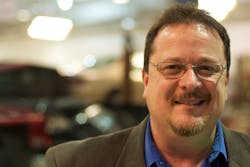Guy Salvadori, manager of Carman Collision Center in New Castle, Del., knew something had to change at his facility.
He noticed a painter would be busy one week while another employee would be standing around, doing nothing and waiting for new work to come his way. The next week, a different employee was busy while others sat unproductive.
“This is ridiculous, it has to stop,”he thought.
Salvadori had heard of a team-pay concept that required shop staff to work together on every car, rather than each tech working separately. The idea was that repairs would get done more quickly and staff would become more focused on producing as a team for their collective benefit.
For Salvadori, the system’s benefits were even more far-reaching. After implementing a team system two years ago, his shop’s efficiency and profitability quickly transformed. In just one month, cycle time dropped by almost four days, and the shop increased touch time by about two hours. Salvadori nearly doubled monthly revenue from $198,000 per month to $367,000 per month, and recently completed a $150,000 office renovation funded by the business’ growth. “Everything has changed,” he says. “It’s incredible.”
Salvadori first noticed his facility’s productivity problem in the paint department, so that’s where he first tested team pay. Here’s how it worked:
Each team member was paid a flat rate at a percentage of the shop’s billable hours. The top technician received the largest percentage and led other team members in staying efficient. The more billable hours produced for the shop, the more money an employee earned.
Pay Matrix
Here’s an example of an average pay matrix on a team system, as provided by industry consultant Randy Ferrese, who has helped collision shops implement team-based systems. Employees are paid a higher or lower share based on their experience, training, and responsibility level, among other qualifications.
Total billable hours worked during a pay period: 300
Payroll due: $5,544
Results were immediate; in just 30 days under the team pay plan, cycle time dropped 3.6 days.
After the first test, he knew he needed to expand the system throughout his 21-person, 13,000-square-foot facility. He prepped his employees for six months, meeting regularly for up to an hour at a time to discuss changes that would take place, why they were making the change, and any problems that needed resolving.
Before this, Salvadori ran a typical shop with a frame and body department, and a paint department. But with a team-pay system, he created task-specific positions so the entire shop could work on one car together. These new positions included disassembly, structural tech, body panel hangers, body filler techs, reassembly, mechanical tech and detailers, paint preppers and paint sprayers.
He was honest with his team, saying that he knew the system wasn’t for everyone and that he might lose people. He was right; he lost 50 percent of his staff, and nearly gave up on the plan. “It was very, very, very difficult,” he says, noting that the dealership principals pushed back because of the ripple effect it had throughout the organization. For example, even payroll and hiring practices changed. But Salvadori stuck with the program, which was worth it for everyone, he says.
Randy Ferrese, a consultant for Summit Software Solutions and sales manager for the country’s northeast region, has helped collision shops implement team pay. In the last two years in his market, he’s seen about 15–20 shops change to this system.He and Salvadori shared some tips for making the transition:
Choose your team wisely. Salvadori says switching to a team system quickly reveals each person’s weaknesses. For example, if your estimator isn’t consistently accurate, then the entire team working on the vehicle together will be affected. Or if someone isn’t doing well with bodywork, that person needs to be trained, moved, or let go, Salvadori says.
Pick a leader. The person who can be a staff leader is diplomatic, educated and can solve problems easily, “instead of screaming, yelling and cussing,” Salvadori says. After a while, workers learn to self-manage so they’re mentally engaged to be accurate and efficient.
Staff must be punctual. If one person is behind, it throws the whole team off, so stick to the schedule.
Take care of shop equipment. In a team environment, equipment must stay in the right place so everyone knows where to access it. Keep parts organized.
Meet weekly. It’s important to talk as a group, give the team a chance to offer feedback, and solve problems together.
Salvadori says while his team has been highly successful, he still thinks he’s not at 100 percent capacity in terms of efficiency. He says he’s about 75 percent there; they’re currently repairing around 190 cars per month. As his shop has evolved, he has learned some valuable lessons. He and Ferrese offer this advice:
This system isn’t for everyone. As a shop owner or manager switching to this system, you have to have smooth and clear repair processes. Ferrese says disassembly is paramount. Goals must be clear, and managers must know how to pace and balance the workload.
Show workers why you’re doing this. Don’t switch to team pay just to save money, Ferrese says. Employees will not trust that the system will benefit them. The numbers prove it’s more efficient, but this system can also be an opportunity for some employees to make more money. Show employees you care about them, and they will perform well.
